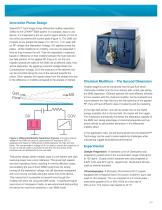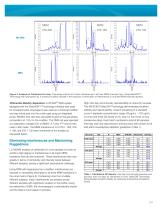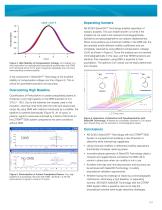
Brochure: AB SCIEX SelexION? Technology: A New Solution to Selectivity Challenges in Quantitative Bioanalysis
1 /
5Pages
Catalog excerpts

AB SCIEX SelexION™ Technology: A New Solution to Selectivity Challenges in Quantitative Bioanalysis Differential Mobility Separations Enhanced with Chemical Modifiers: A New Dimension in Selectivity Yves LeBlanc, Doina Caraiman, Mauro Aiello, and Hesham Ghobarah AB SCIEX, Toronto, Canada High selectivity is a key component of successful quantitative bioanalysis. The ever increasing sensitivity and throughput requirements of bioanalytical assays often pose method development challenges. One of the most common issues encountered is the presence of a matrix interference which must be eliminated by adjusting HPLC conditions, or modifying sample preparation. Interferences can be present as an un-resolved chromatographic peak, or as a high baseline. In some cases, separation of isomers is required. If a high baseline problem cannot be solved, LOQ’s and dynamic range are adversely impacted. Resolving a difficult chromatographic interference can require slower chromatography or more complicated and labor intensive sample clean-up. It also slows down data review if peak integration has to be manually adjusted on a sample by sample basis. Significant advances have been made in increasing MS/MS selectivity beyond the gold standard MRM. For example, MRM3 on the QTRAP® 5500 system adds additional selectivity by increasing the number of fragmentation steps. Ion mobility presents another attractive option by introducing additional selectivity during sample introduction, following atmospheric pressure ionization. Although ion mobility techniques have been used extensively for qualitative applications, they have traditionally lacked the required ruggedness and speed required for quantitative bioanalysis. The AB SCIEX SelexION™ Technology with the QTRAP® 5500 system brings the power of differential ion mobility separation to complex bioanalysis, enabled by multiple new innovations in ion mobility. Key SelexION™ Technology Innovations • The introduction of chemical modifier adds a new dimension to selectivity and dramatically increases separation capacity. • Planar geometry results in high speed and minimal diffusion losses for maximum sensitivity and UHPLC compatibility. • Highly robust, reproducible, and stable for use in regulated bioanalysis. • Easy to maintain, and can be Installed or removed in minutes with no need to break vacuum or use any tools. Differential Mobility Cell Compact and simple design allows the cell to be installed without the use of any tools and in less than two minutes. SelexION™ Curtain Plate Updated version of the traditional curtain plate to accommodate the differential ion mobility cell. Maintains the same level of robustness and stability associated with the original design. Figure 1. SelexION™ Technology. The DMS interface is directly coupled to the orifice plate. A modified curtain plate accommodates the DMS cell which can be easily installed and removed without the use of any tools and without venting the system. The source extension ring enables use of the ® standard AB SCIEX Triple Quad™ and QTRAP system sources. p1
Open the catalog to page 1
Innovative Planar Design SelexION™ Technology brings differential mobility separation (DMS) to the QTRAP® 5500 system in a compact, easy to use device. It is integrated in the ion source region directly in front of the orifice and behind the curtain plate (Figure 1). The DMS cell consists of two parallel flat plates (10 x 30 mm, 1 mm gap) with an RF voltage (the Separation Voltage, SV) applied across the plates. Unlike traditional ion mobility, ions are not separated in time as they traverse the cell. They are separated in trajectory based on difference in their mobility between the high...
Open the catalog to page 2
Figure 3. Analysis of Clenbuterol in urine. This assay suffers from matrix interferences in all three MRM channels (top). Using SelexION™ Technology with isopropanol as a chemical modifier resulted in the reduction or elimination of interferences in all three MRM channels (bottom). Differential Mobility Separation: A QTRAP® 5500 system equipped with the SelexION™ Technology interface was used for all experiments. Isopropanol was used as a chemical modifier and was introduced into the curtain gas using an integrated pump. Modifier flow rate was calculated to give a final gas phase...
Open the catalog to page 3
Separating Isomers Normalized Signal Red: Time 0 hr Black: Time 1 hr Green: Time 3 hr Blue: Time 4 hr Pink: Time 20 hr Grey: Time 21 hr Purple: Time 23 hr Brown: Time 24 hr Figure 4. High Stability of Compensation Voltage. CoV stability is a key requirement for reproducible bioanalytical quantification with DMS. CoV remained within 0.01V when measured repeatedly over 24 hours demonstrating excellent stability. AB SCIEX SelexION™ Technology enables separation of isobaric analytes. This can enable shorter run times if the analytes do not need to be resolved chromatographically. Ephedrine and...
Open the catalog to page 4
Bradley B. Schneider, Thomas R. Covey, Stephen L. Coy, Evgeny V. Krylov, and Erkinjon G. Nazarov, Anal. Chem. (2010), 82, 1867–1880. B. B. Schneider, et al., Int. J. Mass Spectrom. (2010), 298, 45-54. B. B. Schneider et al., Eur. J. Mass Spectrom. (2010), 16, 57-71. For Research Use Only. Not for use in diagnostic procedures. © 2011 AB SCIEX. The trademarks mentioned herein are the property of AB Sciex Pte. Ltd. or their respective owners. AB SCIEX™ is being used under license. Publication number: 2960211-01
Open the catalog to page 5All SCIEX catalogs and technical brochures
-
SelexION
8 Pages
-
SCIEX VISION
32 Pages
-
MPX™
13 Pages
-
NanoLC™ 400
8 Pages
-
API 3200™ LC-MS/MS SYSTEM
8 Pages
-
3200MD
8 Pages
-
MicroLC 200 Plus
6 Pages
-
SelexION™
26 Pages
-
x500R
8 Pages
-
SCIEX TRIPLE QUAD™ 5500 SYSTEM
12 Pages
-
ExionLC 100 Extended Specs
2 Pages
-
PA 800 plus Catalog
16 Pages
-
Eksigent Ultra LC Systems
6 Pages
-
Ekspert NanoLC 400
7 Pages
-
Micro LC and cHiPLC Columns
6 Pages
-
ProteinPilot Software
6 Pages
-
MultiQuant Software
6 Pages
-
MetabolitePilot Software
6 Pages
-
AB SCIEX TripleTOF® 5600+ System
12 Pages
-
Brochure: Targeted Protein Quant
12 Pages
-
Brochure: Discovery Proteomics
12 Pages
-
Brochure: AB SCIEX TOF/TOF? 5800
12 Pages





























































